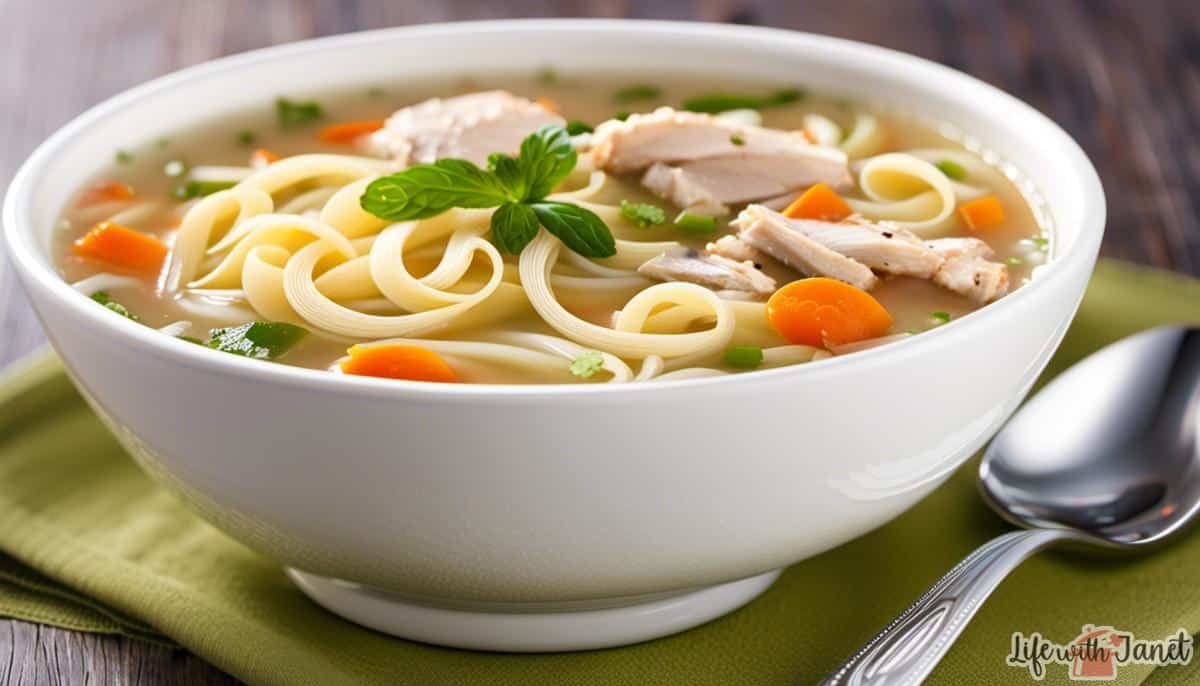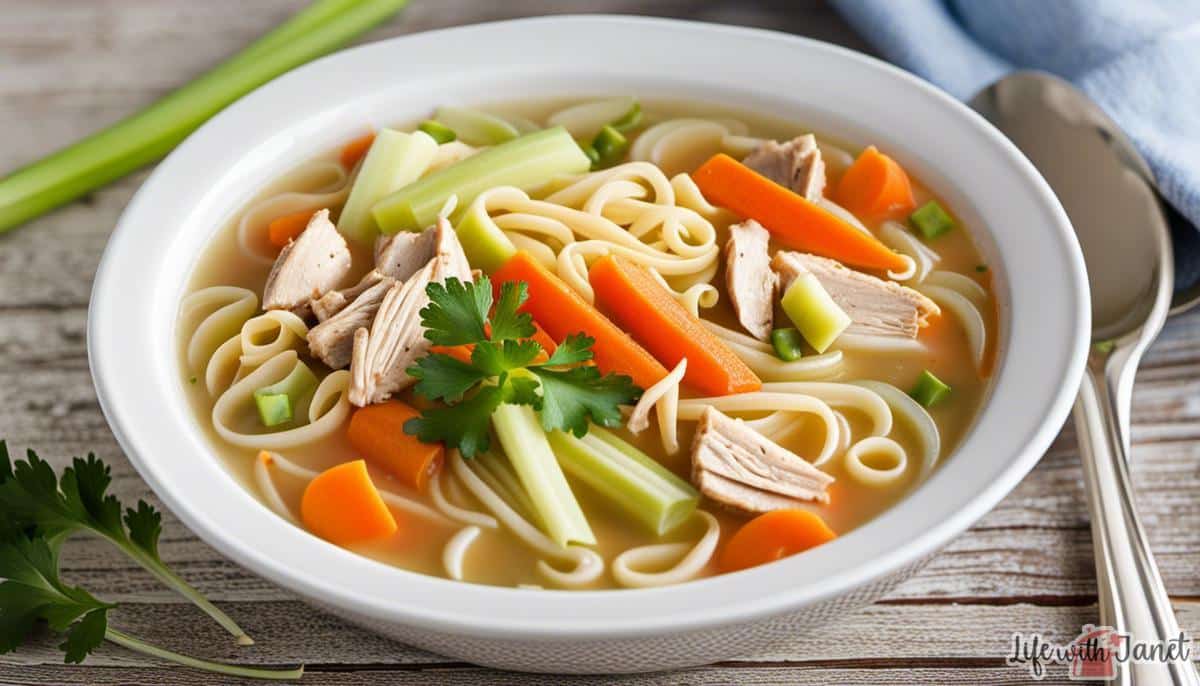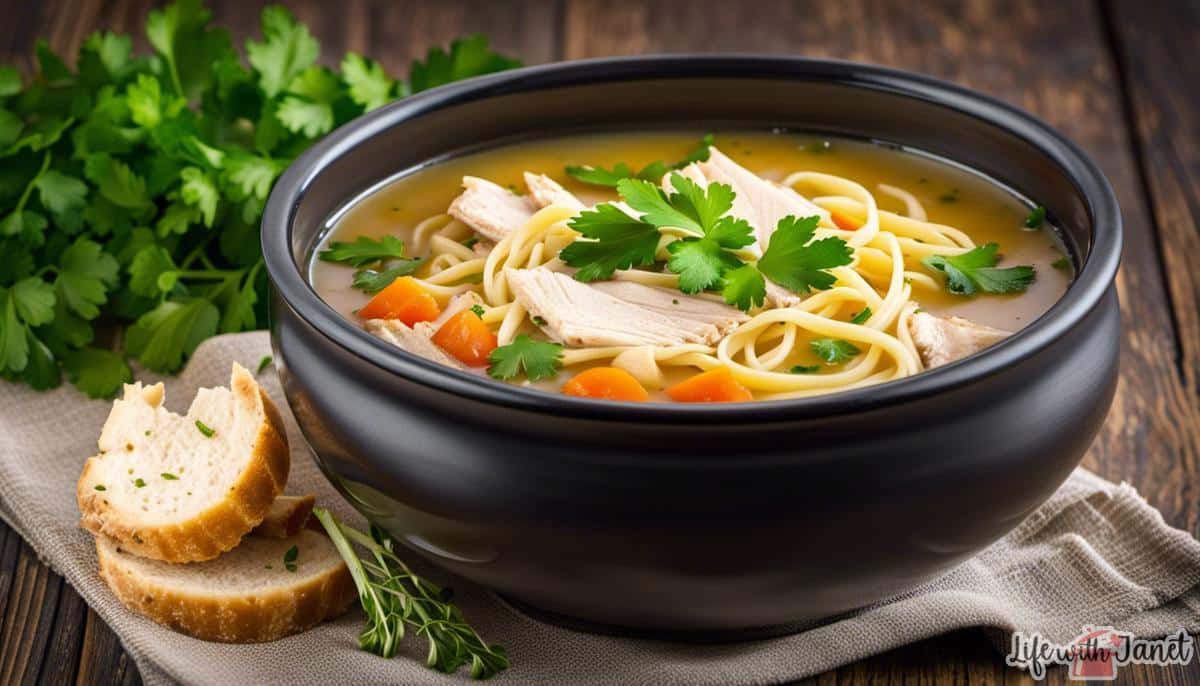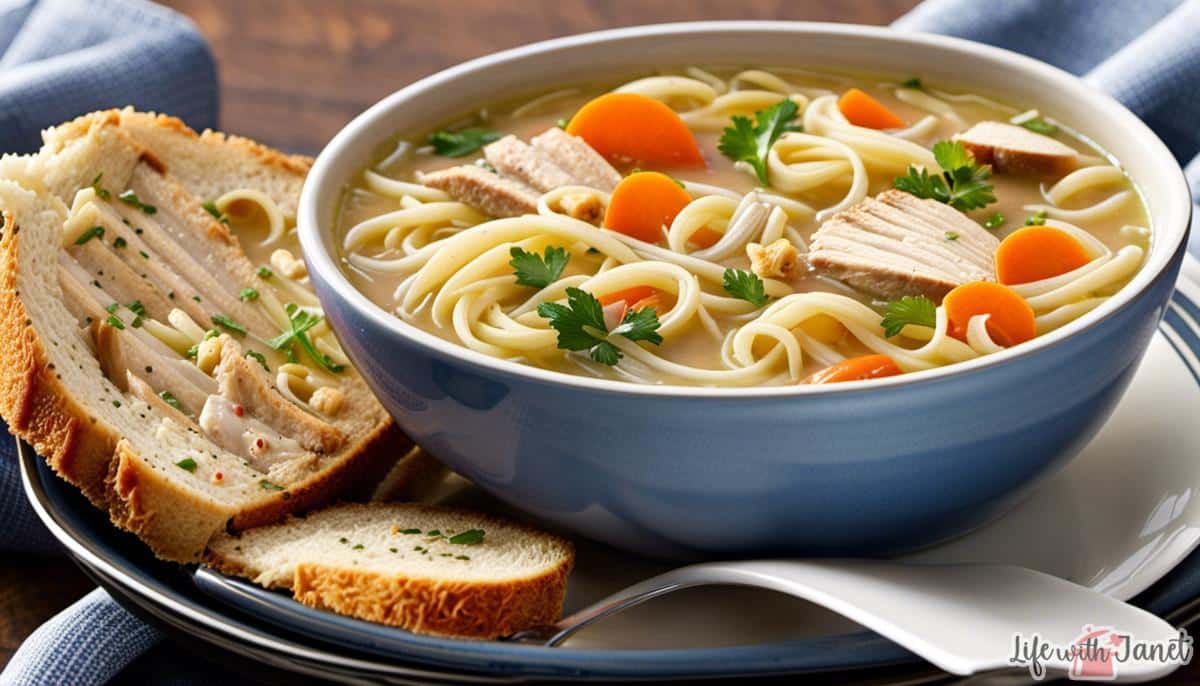WANT TO SAVE THIS RECIPE?
There’s something undeniably comforting about a piping hot bowl of chicken noodle soup, a true culinary globe-trotter that has trotted its way into the hearts and kitchens of almost every culture worldwide. Our quest to understand the humble chicken noodle soup unravels a rich, storied history, introducing us to a fabric of traditions, experiments, and cultures. It’s not just another recipe; it’s a testament to the universal language of food and its power to heal, nourish, and bring people together. As we deep dive into its dawn and evolution, source the ingredients that come together in harmony to create this comfort dish, and finally, dissect our way into making a simmering pot of it all by ourselves, we will also uncover the soup’s greater role in our home and society.
The History of Chicken Noodle Soup
Origins of Chicken Noodle Soup
Chicken noodle soup, a staple in American households, is believed to have ancient roots leading back to the Eastern Han Dynasty, around 25-220 AD. During this period, historian Yin Juping reported a dish named “Chicken and Green Onion Dish with Noodles.” However, its development into the form we recognize today likely took place over centuries, with different cultures adding their unique spin.
The Spread of Chicken Noodle Soup
The spread of this soup corresponded with the rise of popularity of chickens in Europe and the Americas. While chickens were domesticated as early as 2000 BC in Asia, they did not become widely consumed in Europe until the Middle Ages. Similarly, in America, chickens were initially raised for cockfighting purposes and only became a diet staple in the 19th century. With more chickens available, the incorporation of chicken in soup became commonplace.
Popularity of Chicken Noodle Soup
In the United States, the popularity of chicken noodle soup skyrocketed in the 1930s with the introduction of Campbell’s ready-to-serve chicken noodle soup. The product, simple to prepare and affordable, struck a chord with consumers during the hardships of the Great Depression. Since then, the prepackaged version of chicken noodle soup has remained a pantry staple in many American homes.
Chicken Noodle Soup in Different Cultures
Chicken noodle soup’s ingredients and name vary across cultures. Italians have their chicken noodle equivalent in Minestra di pollo. The Chinese version is called Mǐfěn tāng, while the Vietnamese version, Phở gà, is noodle soup with chicken instead of the usual beef. Further, in the Dominican Republic, Sopa de pollo con fideos is a cultural staple. Despite the different names and slight variations in ingredients, the purpose of these soups remain the same: comfort and nourishment.
Chicken Noodle Soup as Comfort Food
Often considered a cure for the common cold, chicken noodle soup’s reputation as a comfort food stems from its warm, filling nature, and the relative ease with which it can be prepared. In fact, it has been scientifically proven that hot chicken soup can ease the symptoms of upper respiratory tract infections due to its anti-inflammatory effects.
A Closer Look at Chicken Noodle Soup
A cherished staple in many cultures, chicken noodle soup is often equated with feelings of home, comfort, and care. It is traditionally served to those who are unwell, as it provides soothing nourishment that is easily digested. This heartwarming dish is not only for the ailing, however; chicken noodle soup is also a usual sight during festive occasions as it symbolizes unity, hospitality, and abundance.

Ingredients and Nutritional Benefits
Ingredients and Nutritional Value
Despite being a staple comfort food, chicken noodle soup is remarkably beneficial to our health due to the nutritional values of its ingredients.
Take chicken, the main ingredient, for instance. This lean meat is a fantastic source of high-quality protein which aids in muscle growth, repair, and maintenance. It also offers essential vitamins and minerals like Vitamin B6, niacin, and selenium that are crucial for energy metabolism and shielding our cells from oxidative stress.
The noodles in the soup are also noteworthy, especially if they are made from whole grains. These fibers can aid in digestion and are known to reduce the risk of certain health conditions such as heart disease, stroke, and specific types of cancer.
The broth, which is primarily comprised of water and chicken bones, contributes a significant amount of protein to the soup. Additionally, if prepared at home, the broth could be a source of collagen which plays a vital role in maintaining healthy skin, hair, and nails.
Vegetables like carrots, celery, and onions are the final key components that not only add a burst of flavor but also a wealth of nutrients to the soup. Carrots are rich in beta carotene, vitamin K1, and potassium and are packed with antioxidants. Celery provides vitamin K and A, amongst other essential minerals. Onions are a treasure trove of antioxidants and compounds that stave off inflammation, decrease triglycerides and cholesterol levels, and thus, potentially lower the risk of heart diseases.
Variations and their nutrition
There are several variations of Chicken Noodle Soup based on different cuisines, and each variation’s nutritional content depends on its unique set of ingredients.
For instance, an Asian-inspired version of Chicken Noodle Soup often includes ginger, garlic, sesame oil, soy sauce, and sometimes even mushrooms. These additions enhance the soup’s nutritional profile. Ginger is known for its anti-inflammatory and antioxidant effects. Garlic has been recognized for its potential to boost immune function. Mushrooms are high in various vitamins, minerals, and antioxidants, including vitamin B and selenium.
A Mexican-style Chicken Noodle Soup, or ‘Sopa de Pollo’, might include ingredients like avocado, lime, coriander, and spicy peppers, all of which provide their own set of health benefits. Avocadoes are highly nutritious and loaded with heart-healthy monounsaturated fats and fiber. Lime offers vitamin C and antioxidants, and spicy peppers contain capsaicin, which has been studied for its metabolism-boosting and appetite-suppressing properties.
Choosing the Best Ingredients
To create the most flavorful and nutritious Chicken Noodle Soup, it’s important to select fresh, organic, and locally sourced ingredients. By doing so, you concentrate the flavor and maximize the health benefits of your soup.
Consider purchasing locally raised chickens, since they are typically given fewer antibiotics and fed premium diets compared to those from large-scale poultry farms. Opt for whole grain noodles, which are typically available at local health food stores or online. For vegetables, fresh is best – head to your local farmers’ market for the freshest, most mineral-rich options vs. store-bought or frozen versions.
Ultimately, the key to maximizing the nutritional impact of your Chicken Noodle Soup lies in your ingredients. Invest in quality, choose natural, and enjoy the process of homemade cooking.

Step-by-step Guide to Making Chicken Noodle Soup
Gathering Your Ingredients and Tools for Chicken Noodle Soup
Creating a satisfying bowl of Chicken Noodle Soup requires you to gather the appropriate ingredients and equipment first. Your shopping list should include a whole chicken for a richer taste, whole grain noodles, fresh vegetables like carrots, celery, and onions, and herbs and seasonings such as parsley, salt, and pepper. Remember, the best chicken noodle soup starts with the best ingredients, so choose wisely.
As for equipment, you will need a large pot to cook your soup, a quality knife and chopping board for preparing your ingredients, a sieve for straining, and a few bowls for serving. With the right tools and ingredients, your chicken noodle soup will be a culinary triumph.
Step 1: Prepare the Chicken
Begin by placing the whole chicken in a large pot, adding enough water to cover it. You may also include some basic seasonings at this point such as salt and pepper. Bring it to a boil, then reduce the heat and let it simmer. Skim off any foam or impurities that float to the top.
Step 2: Cook the Chicken
Allow the chicken to cook fully until it’s tender. This process usually takes around 1 and a half hours, but it can vary depending on the size of the bird. Once the chicken is fully cooked, remove it from the pot and place it in a separate bowl to cool.
Step 3: Prepare the Vegetables
While the chicken is cooling, dice the carrots, celery, and onions. Aim for pieces that are all roughly the same size to ensure even cooking. Once the chicken is cool enough to handle, remove the meat from the bone and shred it into bite-sized pieces. Discard the bones and any skin.
Step 4: Strain the Broth
Strain the broth to remove any remaining impurities. If desired, you can reduce the broth for a more concentrated flavor. Keep in mind that reducing the broth will also increase the saltiness, so adjust your seasonings accordingly.
Step 5: Add the Vegetables and Chicken
Return the strained broth to the stove, add the diced vegetables, and bring the soup up to a simmer. Cook until the vegetables are tender. Stir in the shredded chicken and continue to cook until the chicken is heated through.
Step 6: Cook the Noodles
While your soup is simmering, cook the noodles separately as per the packet instructions. Once they’re done, drain them and add them to the soup. You can also add some fresh parsley for an extra touch.
Pro Tips for the Perfect Chicken Noodle Soup
- You can substitute the water with chicken broth for a more robust taste. Just be careful about the amount of salt you add as store-bought broth often contains sodium.
- Do not overcook your noodles. If you won’t serve all the soup at once, consider storing the noodles separately to prevent them from getting mushy in the leftovers.
- Using a whole chicken provides the most flavor, but for convenience, chicken pieces or even deboned meat will work.
Chicken noodle soup, widely savored across the globe, is a comforting dish encompassing chicken, noodles, and a flavor-packed vegetable broth. The core ingredients remain the same, yet the recipe is extremely flexible, allowing for variety. Popular modifications include using different types of noodles, experimenting with a variety of vegetables, and incorporating other ingredients you might have available.

Impacts and Usage of Chicken Noodle Soup in Modern Culture
Chicken Noodle Soup – An Ultimate Comfort Food
Embraced worldwide, chicken noodle soup is synonymous with warmth, comfort, and nourishment. It’s an all-time favorite, particularly in times of illness, cold weather, or when one needs a little culinary uplift. The soup’s heat combined with the homely tastes of chicken, vegetables, and noodles not only soothes the soul but also nourishes the body. The noodles provide carbohydrates, ensuring an immediate energy supply, contributing to a sense of fulfillment and wellbeing.
Family Gatherings and Chicken Noodle Soup
In many households, particularly those with strong culinary traditions, chicken noodle soup is often a staple at family gatherings and special occasions. The soup can serve as an appetizer, a main course, or even a side dish, and is usually a crowd pleaser due to its universally appealing taste and ingredients. It can be easily and inexpensively made in large quantities, making it a practical choice for feeding large groups. It’s not uncommon for family recipes to be passed down through generations, further ingraining the soup into family traditions and shared memories.
Chicken Noodle Soup as a Flu Remedy
The use of chicken noodle soup as a remedy for the common cold or flu has become so mainstream that it’s often referred to as “Jewish penicillin”. This phrase comes from the traditional Jewish belief in chicken soup’s curative properties, and it’s an idea backed up by some modern medical research. The hot liquid helps soothe a sore throat and can also act as a natural decongestant. The nutritional content of the soup – including the chicken, which is rich in protein – supports the body’s healing processes. Some studies suggest that the ingredients in chicken soup, such as onions, garlic, and celery, might contain substances that inhibit neutrophil migration, reducing inflammation and allowing the body to recover more quickly.
Chicken Noodle Soup in Pop Culture
Chicken noodle soup has also found its way into pop culture. From Seinfeld’s famous “Soup Nazi” episode to its mention in countless television shows, movies, and songs, this dish is a recognizable staple in American culture. Additionally, Campbell’s Soup Company has capitalized on this popular soup by using it heavily in marketing efforts, making “Campbell’s Chicken Noodle Soup” not just a meal, but an iconic symbol.
Some Unique Variations
While classic chicken noodle soup is timeless, there are countless variations to the recipe that reflect different cultural influences and personal taste preferences. For instance, Vietnamese Pho Ga incorporates rice noodles and aromatic herbs, while Greek Avgolemono introduces a tangy twist with lemon and egg. All these versions contribute to the global modern culture, showcasing the diversity and adaptability of this beloved dish.

Unraveling the realm of chicken noodle soup, there’s a world of intricate detail waiting to be discovered, and we did just that – charted its beginnings, illustrated its composition, and even learned to recreate the magic at home. The humble soup has proved its timeless adaptability, nourishing generations, and leaving its mark on countless cultural landscapes. But more than just a bowl of food, it is a bowl brimming with memories, remedy, and warm comfort; proof that something so simple can carry great depth. A bowl of chicken noodle soup doesn’t just feed our bodies, it tells a story, strengthens the bond of families and communities, and in quiet ways, restores our faith in the power of food.
Ingredients
- 1 pound of chicken boneless, skinless, either breast or thighs
- A hearty 8 cups of chicken broth
- A splash or two of water about 2 cups
- Carrots: 2 peeled and artistically sliced
- 2 stalks of celery also sliced but not too thin
- 1 onion finely chopped
- 3 cloves of garlic minced to release their aroma
- 1 bay leaf for that rustic touch
- Thyme? Yes please! 1 teaspoon, dried
- 1 teaspoon dried parsley for color and flavor
- Salt and pepper to your taste buds’ content
- 2 cups of egg noodles because what’s a soup without noodles?
Instructions
- Chicken Prep Time: Whether you go for the breast or thighs, make sure to cut them into bite-sized pieces—or leave the thighs whole if you’re feeling rustic. Your choice!
- Searing the Bird: Drizzle some oil in a grand Dutch oven or a large saucepan, then heat it to medium. Lay the chicken pieces carefully into the hot oil. Brown them until they’re as golden as an autumn leaf—about 5 minutes. Then remove them and set aside, because they’ll be back!
- Veggie Sauté: In the same pot—no need for extra dishwashing—throw in your chopped onion, minced garlic, carrot rounds, and celery slices. Sauté until the kitchen smells like heaven and the veggies are soft, usually around 5 minutes.
- Broth and Seasoning Fusion: Pour in that rich chicken broth and water. Sprinkle in your bay leaf, thyme, and parsley. Don’t forget the salt and pepper. Give it a good stir; you want those flavors mingling.
- Boil & Simmer: Raise the heat to bring your pot of comfort to a rolling boil. Then, cut the heat back down, letting it simmer for 20 minutes. This will make sure the flavors are more married than a couple celebrating their golden anniversary.
- Noodle Business: As your soup is cooking up its flavors, separately boil those egg noodles according to the package’s wisdom. Once done, drain and set them aside. They’re the last-minute heroes in this saga.
- Chicken’s Second Coming: Remember the chicken set aside? Now is their moment of glory. Back into the pot they go. Simmer until the chicken is so tender it practically melts in your mouth, about 10 more minutes.
- Noodles & Finishing Touches: Once the bay leaf has done its duty, fish it out and toss it. Stir in the cooked noodles. Taste. Need more salt or pepper? Adjust accordingly.
- Serve It Up: Ladle this piping hot, soul-soothing Chicken Noodle Soup into bowls and serve right away. Enjoy every comforting spoonful!










